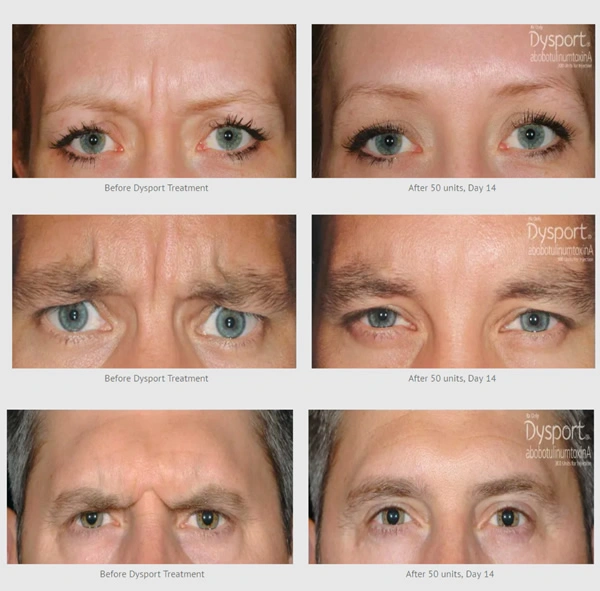
When it comes to smoothing away wrinkles around the forehead, eyebrows and eyes, injections of a neurotoxin are the way to go. These prescription medications contain tiny amounts of the botulinum toxin, which relaxes facial muscles that are responsible for the formation of some creases. At Cross Hudson Plastic Surgery, we offer two different neurotoxins to our patients: Botox and Dysport. While Botox is the more well-known products of the two, Dysport is gaining momentum in the cosmetic and plastic surgery space.
Both of these botulinum products work similarly, but subtle differences between the two also allow us to tailor your procedure to your precise needs and desired outcome. The formulations are designed to smooth away dynamic wrinkles – the lines that form when you make certain facial expressions. These include:
While neurotoxins offer superior results in these areas of the face, they are not as effective on lines and wrinkles that tend to appear on the lower portion of the face. However, Dr. Mordkovich also offers dermal filler treatments for these wrinkles, ensuring you can achieve full anti-aging results right in his office in a quick procedure that does not require any downtime afterward.
For many years, Botox was considered the gold standard in injectable anti-aging treatment due to its unique ability to reduce moderate to severe wrinkles in the upper face. In 2009, that all changed with FDA-approval of Dysport. This Botox alternative offers the same active ingredient and the same effects, even with its use as a medical procedure for the same conditions Botox treats. For doctors, there was now a competing product they could begin testing and recommending to their patients. Now, you have another option if Botox is not your ideal choice.
Despite their many similarities, there are some differences between these two products that may mean one works better for you than the other. Dysport and Botox affect the skin differently based on their molecular structure. Though both formulations contain botulinum toxin type A, Dysport is made of smaller molecules. While Botox is a more stable product that remains within the radius of the injection site, Dysport slightly diffuses into the area offering a softer appearance.
Another primary difference between Dysport and Botox is the speed in which the formulations work. Botox affects the skin sooner after the injection, which may be essential for patients looking for rapid results. Dysport, on the other hand, takes a couple of days to smooth your wrinkles, but the results will depend in part on how your skin responds to the medication.
Dysport injections are quick, taking just a few minutes to complete. The injections are relatively painless, and you will be able to resume your routine immediately following your procedure. Any mild bruising or swelling around the injection sites will subside within a matter of hours in most cases.
Results of your Dysport treatment will improve in the days following your procedure as the medication diffuses and spreads throughout the treatment area. Patients usually find the results of Dysport last an average of four months, similar to Botox injections. At that time, you can schedule another appointment to maintain your more youthful appearance.
Ultimately, the success of each facial injectable depends on the skill and knowledge of the injector. You should always look to have injections done through a dedicated plastic surgeon that is a certified injector for Dysport. Dr. Mordkovich has an intimate knowledge of facial muscles, nerves and skin care to offer you the best results with Dysport. At your consultation, we will discuss your skin and what Dysport can do for you. If you’re curious about other injectables at this time, we can also go over those benefits as well.
Cross Hudson Plastic Surgery is happy to answer any preliminary questions you may have about Dysport at 201-751-9490. Call us today to schedule a consultation and find out if Dysport is a good choice for you.